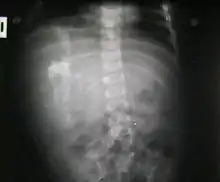Fetus in fetu
Fetus in fetu (or foetus in foetu) is a developmental abnormality in which a mass of tissue resembling a fetus forms inside the body. An early example of the phenomenon was described in 1808 by George William Young.[1]



There are two theories of origin concerning "fetus in fetu". One theory is that the mass begins as a normal fetus but becomes enveloped inside its twin.[2] The other theory is that the mass is a highly developed teratoma. "Fetus in fetu" is estimated to occur in 1 in 500,000 live births.[3]
Classification as life
A fetus in fetu can be considered alive, but only in the sense that its component tissues have not yet died or been eliminated. Thus, the life of a fetus in fetu is akin to that of a tumor in that its cells remain viable by way of normal metabolic activity. However, without the gestational conditions in utero with the amnion and placenta, a fetus in fetu can develop into, at best, an especially well differentiated teratoma; or, at worst, a high-grade metastatic teratocarcinoma. In terms of physical maturation, its organs have a working blood supply from the host, but all cases of fetus in fetu present critical defects, such as no functional brain, heart, lungs, gastrointestinal tract, or urinary tract. Accordingly, while a fetus in fetu can share select morphological features with a normal fetus, it has no prospect of any life outside of the host twin. Moreover, it poses clear threats to the life of the host twin on whom its own life depends.[4]
Theories of development
There are two main theories about the development of fetus in fetu.
Teratoma theory
Fetus in fetu may be a very highly differentiated form of dermoid cyst, itself a highly differentiated form of mature teratoma.[5]
Parasitic twin theory
Fetus in fetu may be a parasitic twin fetus growing within its host twin. Very early in a monozygotic twin pregnancy, in which both fetuses share a common placenta, one fetus wraps around and envelops the other. The enveloped twin becomes a parasite, in that its survival depends on the survival of the host twin, by drawing on the host twin's blood supply. The parasitic twin is anencephalic (without a brain) and lacks some internal organs, and as such is unable to survive on its own. As the host twin has to "feed" the enveloped twin from the nutrients received over a single umbilical cord, they usually die before birth.
References
- George William Young (1808). "Case of A Foetus found in the Abdomen of a Boy". Med Chir Trans. 1: 236–64. PMC 2128792. PMID 20895115.
- Chua, JHY; Chui CH; Sai Prasad TR; et al. (2005). "Fetus-in-fetu in the pelvis" (PDF). Annals of the Academy of Medicine Singapore. 34: 646–9. Archived from the original (PDF) on 2007-10-11.
- Grant P, Pearn JH (May 1969). "Foetus-in-foetu". Med. J. Aust. 1 (20): 1016–9. PMID 5815070. — source not consulted; cited here following Hoeffel CC, Nguyen KQ, Phan HT, et al. (June 2000). "Fetus in fetu: a case report and literature review". Pediatrics. 105 (6): 1335–44. doi:10.1542/peds.105.6.1335. PMID 10835078.
- "Journal of Medical Case Reports | Full text | Fetus in fetu : a case report". Jmedicalcasereports.com. Retrieved 2012-11-22.
- Basu A, Jagdish S, Iyengar KR, Basu D (October 2006). "Fetus in fetu or differentiated teratomas?". Indian J Pathol Microbiol. 49 (4): 563–5. PMID 17183856.
External links
| Look up fetus in fetu in Wiktionary, the free dictionary. |
| Wikimedia Commons has media related to Fetus in fetu. |